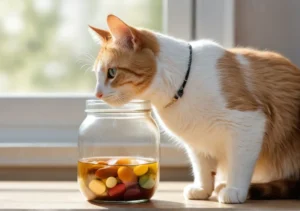Cats have a knack for knocking things over, and jars are often at the top of their target list. It’s a curious behavior that leaves many cat owners scratching their heads, wondering what drives their feline friends to engage in this jar-pushing pastime.
Cats push jars primarily due to their instinctual behaviors, such as curiosity, playfulness, and the need to explore their environment. The sound of a jar rolling or clinking can also engage their predatory instincts, making it an enticing activity. But there’s more to this quirky behavior than just instinct—there may be hidden layers of meaning behind those little paws batting away at your jars.

What are the common reasons cats push jars?
Cats have a knack for getting our attention, and pushing jars is no exception. This quirky behavior can revolve around various motivations that blend instinct with curiosity.
One of the most compelling reasons is play instincts. Cats are natural hunters, and the act of pushing objects like jars can trigger those playful predatory behaviors. As they paw at the jar, they might view it as an intriguing prey item that needs to be batted around and captured.
Another factor is territoriality. Cats love to assert their dominance over their space, and moving objects around is a way to do just that. Pushing a jar off a counter not only brings them satisfaction but also sends a signal to other cats—or even their humans—that they’re in charge.
Curiosity also plays a significant role. Cats are inherently curious creatures, and investigating how far they can push a jar before it tumbles over is a delightful puzzle for them. They enjoy the auditory and visual feedback that such actions create, adding to their overall stimulation.
Additionally, if the jar holds food, their motivation shifts. They might be trying to access the contents, reinforcing their instinct to explore and forage. The need to interact with their environment is at the core of a cat’s pushing behavior, blending so many aspects of their feline nature and personality.
Are cats playing or hunting when they push jars?
There’s often a fine line between play and hunting in a cat’s world, and pushing jars is a fascinating illustration of this overlap. It may look like innocent fun, but beneath those paws, there’s a glimpse into their hunting instincts at play.
Cats typically simulate hunting behaviors when they engage with objects like jars. The act of batting the jar around mimics the movement of prey, triggering their instinct to stalk, chase, and capture. It’s a form of enrichment that engages their bodies and minds simultaneously.
Interestingly, this behavior also allows them to practice essential skills. Cats utilize their paws to grasp, manipulate, and test objects. By pushing jars, they’re not only entertaining themselves but honing their natural abilities. This action can be much more than just play; it serves a deeper purpose aligned with hunting preparation.
Consider these insights:
Research on Felidae Behaviors : Studies show that play behaviors in cats are closely related to their survival techniques.
Mental Stimulation : Engaging in these activities helps prevent boredom and can reduce anxiety, contributing to a happier kitty.
Physical Exercise : Pushing jars can provide a great workout, particularly for indoor cats that might lack opportunities to roam freely.
Instinctual Practice : This behavior enables cats to keep their reflexes sharp, which is crucial in their natural habitat.
Encouraging this behavior through interactive toys or safe jars can enrich their environment further. Just keep an eye on what they play with to ensure it’s safe and suitable for their antics.
Do all cats have this jar-pushing habit?
Not all cats exhibit the same jar-pushing behavior, but certain breeds and personality types seem to lean into it a bit more. Curious and playful breeds like the Siamese, Bengal, and Abyssinian often enjoy activities that involve exploration and manipulation. Their innate desire to investigate makes them more likely to push jars and similar objects off tables.
On the other hand, individual personalities play a significant role too. A social cat that thrives on interaction may push jars out of a desire to engage you or draw your attention, while a more shy cat might simply be expressing its curiosity or annoyance. In contrast, older cats might be less inclined to engage in this behavior due to decreased energy levels. In essence, while some cats have a tendency to push jars, it really boils down to individual personality and breed traits.
What happens when cats push jars off tables?
Cats pushing jars often lead to a series of unintended consequences. The immediate effect is usually a mess, whether it’s shattered glass, spilled contents, or a toppled decoration. Not only can this create a nuisance for you, but it also poses potential safety risks for both the cat and humans in the house.
Here are some considerations regarding the aftermath of this jar-pushing escapade:
- Clean-Up Required: You might find yourself cleaning up food, liquid, or even stray pieces of glass—definitely not a fun chore.
- Accidental Injuries: If a jar shatters, it can cause cuts for both you and your cat. It’s essential to monitor your pet for any injury from broken debris.
- Potential Upsetting of Other Items: A pushed jar can lead to a chain reaction, knocking over other items nearby and causing further chaos.
- Behavior Reinforcement: If the cat notices that pushing a jar consistently gets a strong reaction from you, even if it’s a negative one, they may continue the behavior.
Additionally, if messes become routine, consider making your tables less accessible or redesigning the space to deter this amusing but troublesome habit. Keeping fragile items out of reach is a straightforward yet effective strategy to minimize the chances of mishaps.
How can you redirect this behavior?
If your cat loves to push jars around, you can redirect that playful energy with a few engaging alternatives. Consider interactive toys like laser pointers, feather wands, or treat-dispensing puzzles. These not only keep your feline entertained but also stimulate their natural hunting instincts.
Building a cozy play area can also work wonders. Create a space with climbing structures, scratching posts, and cozy napping spots. This encourages exploration and play without the risk of knocking over fragile items.
Another fun idea is to introduce homemade toys. Take a cardboard box and fill it with crumpled paper or small balls. Your cat will have a blast pouncing around and pushing things instead of your jars. Changing toys regularly keeps their environment fresh and engaging, so switch things up every few weeks to keep excitement high.
Lastly, engage them in some interactive play sessions daily. Dedicate a few minutes to play, using different toys and methods. This helps satisfy their curiosity and desire to interact with their environment without resorting to jar-pushing.
Is there a relationship between jar-pushing and boredom?
Observing your cat push jars can indeed be a sign of boredom or under-stimulation. Cats are naturally curious, and when they lack engaging activities, they tend to create their own. Jar-pushing often becomes an outlet for pent-up energy or a way for them to explore their environment.
An increase in this behavior might indicate they’re not being sufficiently challenged. Look for other signs of boredom too, like excessive grooming, hiding, or meowing more than usual.
Creating a stimulating environment includes:
- Interactive play: Dedicate time each day for active play.
- Environmental enrichment: Use window perches or bird feeders outside to give them something to watch.
- Puzzle feeders: These make mealtime a fun challenge.
- Cat furniture: Climbing trees or shelves can provide physical stimulation.
By providing varied activities and engaging toys, you help curb boredom and reduce those jar-pushing antics. A well-stimulated cat is generally happier, making for a smoother cohabitation.
Are there safety concerns with jar-pushing?
Jar-pushing behavior in cats can definitely raise some eyebrows, especially when you think about the potential safety hazards it presents. Shattered glass from a broken jar can lead to serious injuries, not just for your feline friend but for humans too. Sharp shards can cause cuts to paws or mouths, which might lead to bleeding or infections if not treated promptly.
Another concern is the contents of the jars. If they’re filled with anything toxic, like certain foods or cleaning products, a curious cat can quickly find themselves in a dangerous situation. Plus, there’s always the possibility of a cat pushing a jar off a high surface. If it lands on something delicate—say, your foot or some treasured decor—there’s a chance of injury or damage.
To mitigate these risks, consider placing fragile items out of reach and opting for durable containers in areas where your cat tends to wander. It’s about ensuring a safe environment while allowing them to express their curiosity.
Interesting facts about cat behaviors
Cats exhibit a range of quirky traits that can surprise even seasoned cat owners. One fascinating aspect is their instinctual need to hunt and explore. When a cat pushes a jar, they might be channeling their inner hunter, testing weight, balance, and texture, as they would with prey.
Here are some other interesting tidbits related to cat behavior:
- Purring isn’t just for happiness – Cats purr when they’re in pain or stressed too.
- They bring you ‘gifts’ – A strong instinct drives them to catch and present prey, which might be a simple acknowledgment of their bond with you.
- Cats have a grooming obsession – They spend up to 50% of their waking hours grooming themselves, a vital part of their behavior for hygiene and comfort.
- Napping champions – Cats sleep for about 12-16 hours a day on average, giving them the energy to act out their play and exploration naturally.
Lastly, when they engage in antics like jar-pushing, it’s a blend of playfulness and exploration. Encourage these safe interactions by providing sturdy toys or containers specifically designed for their entertainment.
What do your cat’s jar-pushing habits reveal?
Cats are quirky creatures, and their jar-pushing antics often leave us chuckling—and maybe scratching our heads. When your feline friend nudges, paws, or even swats a jar, it’s more than just a random act. It can provide some insight into their mood and personality.
If your cat pushes jars with enthusiasm, this can indicate a playful or curious nature. They might view those jars as toys, igniting their instinct to explore and engage. Conversely, pushing jars gently, almost timidly, may reflect a more cautious demeanor, suggesting they’re assessing their environment before diving in.
Felines are generally territorial, and pushing jars can signify a form of territorial behavior. By moving the jar around, your cat’s asserting ownership of that space. This behavior can also serve as a way of playing out natural hunting instincts, mimicking how they’d interact with prey.
To break it down, here are a few things to consider when observing your cat’s jar-pushing habits:
- Playfulness: High energy and joy in pushing often suggests your cat’s in a playful mood.
- Curiosity: A cat who’s soft-pawing or nudging the jar may simply be investigating its surroundings.
- Stress: If the behavior seems compulsive or occurs during stressful times, it could be a coping mechanism.
- Territorialness: Frequent pushing of a jar in a specific area might indicate they feel the need to mark their territory.
Always pay attention to the context of the behavior. Changes in jar-pushing habits can signal shifts in your cat’s well-being, so staying observant allows you to better understand your furry companion’s needs. If you notice a sudden change in their habits, it might be worth a chat with your vet.
Alex, a passionate animal lover, has experience in training and understanding animal behavior. As a proud pet parent to two dogs and three cats, he founded AnimalReport.net to share insights from animal experts and expand his knowledge of the animal kingdom.




